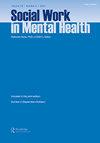年轻人和青少年的非自杀性自伤:历史、文化和临床理解
IF 0.9
Q3 SOCIAL WORK
引用次数: 0
摘要
本文回顾了非自杀性自伤(NSSI)的性质和流行情况,并建议如何在精神卫生界更好地认识和治疗它。纵观历史,自伤一直是许多类型仪式(如文化、宗教、精神和治疗仪式)的核心要素,现在也被视为情感痛苦的病理表达,特别是在西方文化中,自20世纪80年代以来,其发生率急剧增加。自伤涉及没有自杀意图的直接和故意的自我身体伤害。自残可以被视为一种独特的精神健康障碍,是其他精神障碍的定义标准,或者是对创伤或压力的一种短暂反应。尽管其病因,考虑到自伤的发生频率和有害后果,尤其是在年轻人中,自伤应该成为精神病学评估和干预的一个更突出的方面。本文由六个部分组成,描述了与自伤相关的术语;其普遍性、测量方法和变异性(年龄、种族和性别);与其他精神疾病的关系;以及它的诊断和治疗。本文章由计算机程序翻译,如有差异,请以英文原文为准。
Nonsuicidal self injury among young adults and adolescents: Historical, cultural and clinical understandings
This article reviews the nature and prevalence of nonsuicidal self-injury (NSSI) and suggests how it can be better recognized and treated in the mental health community. Throughout history, NSSI has been a core element of many types of rituals (e.g. cultural, religious, spiritual, and healing rituals) and is now also regarded as a pathological expression of emotional pain, particularly in Western cultures, where its occurrence has increased dramatically since the 1980s. NSSI involves the direct and deliberate self-infliction of bodily harm without suicidal intent. Self-injury can be viewed as a distinct mental health disorder, a defining criterion of other mental disorders, or a transient response to trauma or stress. Notwithstanding its etiology, NSSI should become a more salient aspect of psychiatric evaluation and intervention considering its frequency of occurrence and deleterious consequences, especially among young people. The current article consists of six sections that describe the terminology associated with NSSI; its general prevalence, measurement, and variability (age, race, and gender); its relationship with other psychiatric illness; and its diagnosis and treatment.
求助全文
通过发布文献求助,成功后即可免费获取论文全文。
去求助
来源期刊

Social Work in Mental Health
SOCIAL WORK-
CiteScore
1.90
自引率
0.00%
发文量
34
期刊介绍:
Social Work in Mental Health is an exciting contribution from the editors of our highly respected journal, Social Work in Health Care. This journal offers quality articles on clinical practice, education, research, collaborative relationships, mental health policy, and the delivery of mental health care services. This scholarly, creative, and lively journal presents material valuable to social workers in all sectors of mental health care. It is devoted to social work theory, practice, and administration in a wide variety of mental health care settings. Social Work in Mental Health will help you improve your practice in these areas, demonstrating the vital role of social services in mental health care delivery systems.
 求助内容:
求助内容: 应助结果提醒方式:
应助结果提醒方式:


